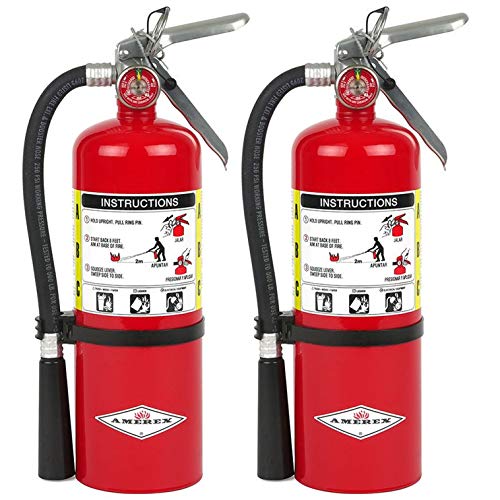Just as a captain navigates murky waters based on the lighthouse's guiding light, the question of fire extinguishers on forklifts isn't always clear-cut. While some see it as a steadfast rule, others dive into the fine print to chart their course. This begs the question…
Are fire extinguishers required on forklifts?
This is a common question among individuals who operate forklifts or work in warehouses where forklifts are used. Forklifts are powerful machines used to lift and transport heavy loads. They are also equipped with fuel systems and electrical components, which can increase the fire risk. Therefore, it is important to ensure fire safety measures, including using fire extinguishers.
According to OSHA regulations, a forklift is not required to be outfitted with a fire extinguisher. Simple. Not exactly. If the forklift comes with a fire extinguisher already mounted, then OSHA requires that a particular fire extinguisher be properly maintained and replaced within clearly printed guidelines.
To be more succinct, OSHA doesn't mandate fire extinguishers on forklifts, but there might be fire protection requirements based on the area's hazards. If a forklift comes with an extinguisher, employers must maintain it and may train operators on its use. Removal of the extinguisher requires the manufacturer's written consent. To learn more about these practices and standards, click here.
The regulations and standards set by organizations such as OSHA and NFPA and state and local regulations make it clear that fire extinguishers are necessary for safety. In the event of a fire, rapid response can be taken to prevent the spread of the fire and minimize damage. Portable fire extinguishers must be mounted in cabinets or braces, 3.5 feet to 5 feet above the floor. If the extinguishers are larger, carrying more weight and volume, they must be placed 3 feet above the floor. OSHA also requires the fire extinguisher to be easily identified in the workplace.
Are Fire Extinguishers Required on Forklifts? OSHA Requirements
General Requirements
OSHA requires that employers provide portable fire extinguishers and mount them in easily accessible locations. These extinguishers must be suitable for the types of fires in that workplace. OSHA also requires that employees be trained in properly using fire extinguishers.
Regarding forklifts, OSHA requires that fire extinguishers be mounted in a location easily accessible to the operator. The extinguisher must be mounted to avoid interfering with the operator's vision or movement.
A vehicle mount that can be used with a forklift can be purchased here.
Fire Extinguisher Types
Fire extinguishers used on forklifts are classified for Class A, B, and C fires.
- Class A fires involve ordinary combustibles such as wood, paper, or cloth.
- Class B fires involve flammable liquids and gases.
- Class C fires involve electrical equipment.
OSHA prohibits the use of fire extinguishers that contain carbon tetrachloride or chlorobromomethane. These chemicals are harmful to humans and the environment.
Inspection and Maintenance
OSHA requires that fire extinguishers on forklifts be inspected monthly. The inspection should ensure that the extinguisher is in the proper location, is fully charged, and is free from damage.
OSHA also requires that fire extinguishers on forklifts be maintained annually. This maintenance should include thoroughly examining the extinguisher to ensure it is in good working condition.
This is all in keeping with the maintenance required of any fire extinguisher, mounted to a forklift or not.
Forklift Manufacturer Recommendations
Manufacturer Guidelines
Regarding fire extinguishers on forklifts, manufacturers often provide guidelines for their equipment. These guidelines may include recommendations for the type of fire extinguisher to use, the location of the extinguisher, and any specific mounting instructions. It is important to follow these guidelines to ensure the safety of operators and others in the workplace.
Some manufacturers may also provide training on properly using fire extinguishers and other safety equipment. This training can be valuable for operators and help prevent accidents and injuries.
Industry Standards
In addition to manufacturer guidelines, industry standards address using fire extinguishers on forklifts. The National Fire Protection Association (NFPA) code and standard, NFPA 505, 2006 edition, paragraph 9, addresses the provision of portable fire extinguishers to lessen possible fire accidents involving forklifts. This standard outlines where the extinguisher should be mounted and recommends that it be easily accessible.
The Occupational Safety and Health Administration (OSHA) 29 CFR 1910.157 standard concerns fire protection. This regulation requires companies to place portable fire extinguishers for employees and to provide an emergency action and fire prevention plan. While this standard does not specifically require fire extinguishers on forklifts, it does mention the need for fire protection in the workplace.
It is important to note that industry standards and regulations may vary by location and industry. Employers should be aware of the specific requirements for their workplace and ensure that they comply.
Conclusion
Are fire extinguishers necessary on forklifts? The short answer: it depends. Regulations can vary based on the nature of work, the work environment, and local laws. Checking with local regulatory bodies and fire safety guidelines for your specific situation is crucial. The goal is to ensure the highest level of safety in all work environments.
